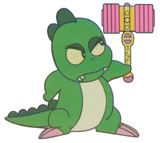A few months ago, many Chinese people and I were greatly astonished by the news that United Nations announced to officially replace using Traditional Chinese by Simplified Chinese from 2008.
Traditional Chinese was simplified from pictograph. Each component of each character is a meaningful picture, a unique ideographic which provides visual comprehensibility, e.g.「手」looks like a hand,「人」looks like a man,「國」is a Country formed with city walls surrounding a mouth (person) and a dagger-axe.
The Traditional characters of today first appeared with clerical script during Han Dynasty and became stable since the 5th Century during the Southern and Northern Dynasties. However, traditional Chinese has many strokes, plus its complex structure make troubles to writing. Thus, simplified characters appeared in different places nationally. The Chinese government believed that the traditional Chinese was too difficult to learn and caused the problem of illiteracy in majority (mainly peasants), therefore, the government started to study character reformation in 1951 and carried out the standardized Simplified Chinese policy in 1956, with the aims to unify Chinese, make it easy to identify, fast to write and to eliminate illiteracy.
Yet over half a century has gone now, over 1.2 billion people of the 1.3 billions are still illiterate. This clearly shows that simplified Chinese does not help to eliminate illiteracy, as illiteracy is the result of ineffective social policy and frequent corruptions.
I learnt simplified Chinese at secondary school, used it for coursework and exams, since subjects like Chinese language, Chinese history and Chinese literature accept using the simplified. Otherwise, we need to write hundreds of Traditional Chinese characters for essays for these subjects, it would be so tiresome especially to write pages quickly during exams.
Using Simplified Chinese is convenient. Nevertheless, why Hong Kong people, Taiwanese and overseas Chinese oppose the United Nations' adoption of simplified Chinese?
1. Characters with more than 10 strokes have to be cut down to below 10 strokes, but those below 10 strokes were unnecessarily simplified, e.g.「馬」(horse) is already simple, but the simplified「马」seemed to have horsehair shaved; though the simplified is easier to write, it loses the sense of beauty, the visual comprehensibility and the vigorous of Chinese.
2. Some unrelated characters are simplified and look similar, but some others sharing the same component do not need to be simplified:「勸」(persuade) became「劝」,「灌」(irrigate) is still「灌」; some words are different in Traditional Chinese but are same in simplified:「乾」(dry) is「干」but「幹」(to do) is also「干」. This indeed raises the complexity.
3. Some people fear that the UN's decision of adopting simplified Chinese would be a pressure causing Chinese worldwide to abandon the Traditional characters. Furthermore, as the mainland Chinese who were born after 1956 do not know Traditional characters, a few decades later,
Traditional Chinese would possibly be obsolete, then even archaeologist cannot decipher Chinese history and culture recorded with these characters. This is a risk of losing our 5,000 years old culture. Someone conjecture that it is a conspiracy to destroy Chinese culture.
From the UN's point of view, China is raising in influence nowadays, its 1.3 billion of population are using simplified Chinese in contrast with only 30 millions are using the Traditional Chinese, it is no reason to keep on using the latter administratively.
Hence, to simplify the Traditional Chinese is a consequence of evolution that no cause for much criticism should be made, it is not either any conspiracy.
Humans always prefer to pick up the easiest. Many foreign Chinese learners who are attracted by Chinese culture lose the courage to the difficult Traditional characters and turn to the simplified. Notwithstanding the new trend, Traditional Chinese can stand the test of time, and we won't lose the 5,000 years old history that easily. As long as we wish to keep the Traditional characters and to protect the traditional culture, why not we Hong Kong people, Taiwanese, or overseas Chinese learn and understand both characters ourselves?
2007年1月14日星期日
訂閱:
發佈留言 (Atom)


沒有留言:
發佈留言